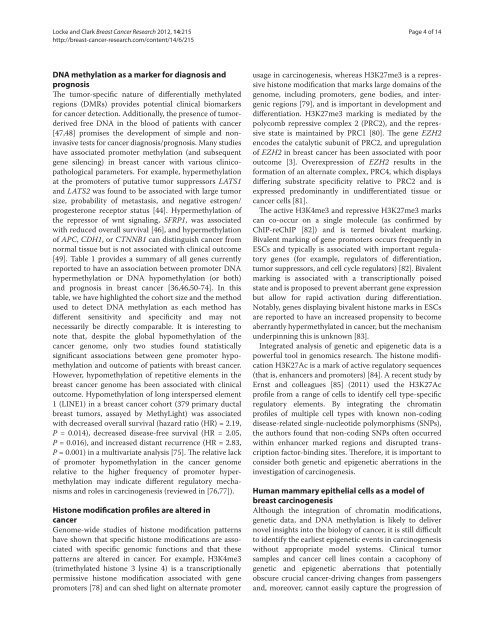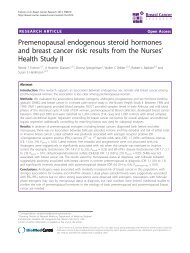PDF - Breast Cancer Research
PDF - Breast Cancer Research
PDF - Breast Cancer Research
You also want an ePaper? Increase the reach of your titles
YUMPU automatically turns print PDFs into web optimized ePapers that Google loves.
Locke and Clark <strong>Breast</strong> <strong>Cancer</strong> <strong>Research</strong> 2012, 14:215<br />
http://breast-cancer-research.com/content/14/6/215<br />
Page 4 of 14<br />
DNA methylation as a marker for diagnosis and<br />
prognosis<br />
The tumor-specific nature of differentially methylated<br />
regions (DMRs) provides potential clinical biomarkers<br />
for cancer detection. Additionally, the presence of tumorderived<br />
free DNA in the blood of patients with cancer<br />
[47,48] promises the development of simple and noninvasive<br />
tests for cancer diagnosis/prognosis. Many studies<br />
have associated promoter methylation (and subse quent<br />
gene silencing) in breast cancer with various clinicopathological<br />
parameters. For example, hypermethylation<br />
at the promoters of putative tumor suppressors LATS1<br />
and LATS2 was found to be associated with large tumor<br />
size, probability of metastasis, and negative estrogen/<br />
progesterone receptor status [44]. Hypermethylation of<br />
the repressor of wnt signaling, SFRP1, was associated<br />
with reduced overall survival [46], and hypermethylation<br />
of APC, CDH1, or CTNNB1 can distinguish cancer from<br />
normal tissue but is not associated with clinical outcome<br />
[49]. Table 1 provides a summary of all genes currently<br />
reported to have an association between promoter DNA<br />
hypermethylation or DNA hypomethylation (or both)<br />
and prognosis in breast cancer [36,46,50-74]. In this<br />
table, we have highlighted the cohort size and the method<br />
used to detect DNA methylation as each method has<br />
different sensitivity and specificity and may not<br />
necessarily be directly comparable. It is interesting to<br />
note that, despite the global hypo methy lation of the<br />
cancer genome, only two studies found statistically<br />
significant associations between gene promo ter hypomethy<br />
lation and outcome of patients with breast cancer.<br />
However, hypomethylation of repetitive elements in the<br />
breast cancer genome has been associated with clinical<br />
outcome. Hypomethylation of long interspersed element<br />
1 (LINE1) in a breast cancer cohort (379 primary ductal<br />
breast tumors, assayed by MethyLight) was associated<br />
with decreased overall survival (hazard ratio (HR) = 2.19,<br />
P = 0.014), decreased disease-free survival (HR = 2.05,<br />
P = 0.016), and increased distant recurrence (HR = 2.83,<br />
P = 0.001) in a multivariate analysis [75]. The relative lack<br />
of promoter hypomethylation in the cancer genome<br />
relative to the higher frequency of promoter hypermethylation<br />
may indicate different regulatory mechanisms<br />
and roles in carcinogenesis (reviewed in [76,77]).<br />
Histone modification profiles are altered in<br />
cancer<br />
Genome-wide studies of histone modification patterns<br />
have shown that specific histone modifications are associated<br />
with specific genomic functions and that these<br />
patterns are altered in cancer. For example, H3K4me3<br />
(trimethylated histone 3 lysine 4) is a transcriptionally<br />
permissive histone modification associated with gene<br />
promoters [78] and can shed light on alternate promoter<br />
usage in carcinogenesis, whereas H3K27me3 is a repressive<br />
histone modification that marks large domains of the<br />
genome, including promoters, gene bodies, and intergenic<br />
regions [79], and is important in development and<br />
differentiation. H3K27me3 marking is mediated by the<br />
polycomb repressive complex 2 (PRC2), and the repressive<br />
state is maintained by PRC1 [80]. The gene EZH2<br />
encodes the catalytic subunit of PRC2, and upregulation<br />
of EZH2 in breast cancer has been associated with poor<br />
outcome [3]. Overexpression of EZH2 results in the<br />
formation of an alternate complex, PRC4, which displays<br />
differing substrate specificity relative to PRC2 and is<br />
expressed predominantly in undifferentiated tissue or<br />
cancer cells [81].<br />
The active H3K4me3 and repressive H3K27me3 marks<br />
can co-occur on a single molecule (as confirmed by<br />
ChIP-reChIP [82]) and is termed bivalent marking.<br />
Bivalent marking of gene promoters occurs frequently in<br />
ESCs and typically is associated with important regu latory<br />
genes (for example, regulators of differen tiation,<br />
tumor suppressors, and cell cycle regulators) [82]. Bivalent<br />
marking is associated with a transcriptionally poised<br />
state and is proposed to prevent aberrant gene expression<br />
but allow for rapid activa tion during differentiation.<br />
Notably, genes displaying bivalent histone marks in ESCs<br />
are reported to have an increased propensity to become<br />
aberrantly hypermethy lated in cancer, but the mechanism<br />
underpinning this is unknown [83].<br />
Integrated analysis of genetic and epigenetic data is a<br />
powerful tool in genomics research. The histone modification<br />
H3K27Ac is a mark of active regulatory sequences<br />
(that is, enhancers and promoters) [84]. A recent study by<br />
Ernst and colleagues [85] (2011) used the H3K27Ac<br />
profile from a range of cells to identify cell type-specific<br />
regulatory elements. By integrating the chromatin<br />
profiles of multiple cell types with known non-coding<br />
disease-related single-nucleotide polymorphisms (SNPs),<br />
the authors found that non-coding SNPs often occurred<br />
within enhancer marked regions and disrupted transcription<br />
factor-binding sites. Therefore, it is important to<br />
consider both genetic and epigenetic aberrations in the<br />
investigation of carcinogenesis.<br />
Human mammary epithelial cells as a model of<br />
breast carcinogenesis<br />
Although the integration of chromatin modifications,<br />
genetic data, and DNA methylation is likely to deliver<br />
novel insights into the biology of cancer, it is still difficult<br />
to identify the earliest epigenetic events in carcinogenesis<br />
without appropriate model systems. Clinical tumor<br />
samples and cancer cell lines contain a cacophony of<br />
genetic and epigenetic aberrations that potentially<br />
obscure crucial cancer-driving changes from passengers<br />
and, moreover, cannot easily capture the progression of






